In this touching story of belonging and environmental awareness, a young boy’s courage and ingenuity help an orphaned rhinoceros find safety in a new herd. Tetenya and his mother have found Faru, a baby rhinoceros, alone on the savannah. They know that rhino herds will adopt orphaned infants, but finding the rangers who protect local herds may be a long and risky prospect—there are poachers lurking about the landscape. Undaunted, Tetenya sets out, leading Faru past giraffes CHOMP-CHOMPING on acacia leaves, amongst the PATTER-PATTERING footsteps of young warthogs, and around guinea fowl SCRITCH-SCRITCHING the earth for seeds. Suddenly, danger is upon them: two poachers are coming near. There are only seconds to spare, and Tetenya has nothing but his wits and a basket of berries to help him.In A Family for Faru, author Anitha Rao-Robinson draws inspiration from her life-changing time spent on the savannah and from conservationists’ innovation to discourage poachers: injecting a pink dye into rhinoceros horns. Award-winning illustrator Karen Patkau’s dreamy landscapes reflect her own travels in the region and celebrate the courage and ingenuity of a young boy as he helps his four-legged friend find a place to belong (Source).
Resource Creator(s)
Anitha Rao-Robinson is a children’s author. Her debut picture book, A Family For Faru, was released in 2020. She has also written a young adult trilogy. Broken Worlds, was published in 2014, followed by Broken Promises (2017) and Broken Dreams (2019). Anitha graduated from Queen’s University in Kingston, Ontario, with a Bachelor of Commerce, and then went on to become a Chartered Accountant. Accounting satisfies her strange attraction to numbers and organization, while writing allows her imagination to soar! She lives on a farm in Ontario with her husband, two children, and their many wonderful animals. Anitha is represented by Tanusri Prasanna (Source).
Karen Patkau was born in Winnipeg, Manitoba. Her mother wrote a telling note on a photo of her at 10 months old, – “Here is Karen looking at a book. She enjoys books, especially those with animals in them.” Karen started drawing at the age of three. In public school she was known as the “class artist.” She graduated from the University of Manitoba with a Bachelor of Fine Arts Honours degree, and became interested in visual storytelling while studying for her Master of Visual Arts degree at the University of Alberta. Today, Karen lives in Toronto. She has been writing and illustrating for many years. Her work appears in children’s picture books, educational publications, posters, advertisements, magazines, package designs, greeting cards and art exhibitions (Source).
Sustainable World Collaborative’s Analysis
We analyzed each resource in our database based on the Ways of Thinking from the Sustainability Education Framework for Teachers. We select only high-rated resources to include in the database. Below are our ratings and notes for this resource.
Systems Thinking

The resource encourages readers to work in collaboration with others in their communities. It also highlights the intersections between poaching, conservation, and community engagement. Front and back matter of the book offer additional information about rhino populations, poaching, and conservation. The resource alludes to a current technology being piloted on rhino populations in South Africa.
Strategic Thinking

The book was published in 2020, capitalizing on most recent scholarship and technology. It proposes solutions to meaningfully protect rhino populations, like the establishment of rhino sanctuaries and the alteration of rhino horns to make them undesirable to poachers.
Values Thinking

The resource positions a child in a position of caretaking for an endangered animal, and highlights the work of community members in protecting the animal. It is a great example of a community’s values informing their response to caring for an endangered animal.
Futures Thinking

The book is reflective of ongoing conservation efforts in South Africa and encourages readers to consider the issue of poaching and rhino population decline. It also reflects the most recent knowledge and scholarship on the issue. The book is connected to the work of the organization: Rhino Rescue Project.
